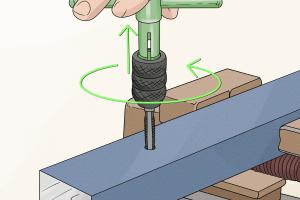Mastering the Art of Using a Tap: A Comprehensive Guide

-
Quick Links:
- Introduction
- What is a Tap?
- Types of Taps
- How to Use a Tap
- Tap Maintenance
- Troubleshooting Common Tap Issues
- Expert Insights
- Case Studies
- Conclusion
- FAQs
Introduction
Using a tap may seem straightforward, but understanding the nuances can greatly enhance your experience and efficiency. This guide is designed to provide you with all the knowledge you need about taps—from their types to maintenance and troubleshooting.
What is a Tap?
A tap, also known as a faucet, is a device that controls the flow of liquid, typically water, from a pipe. Taps are essential fixtures in kitchens and bathrooms, playing a crucial role in our daily lives.
Types of Taps
There are several types of taps, each suited for different applications:
- Compression Taps: Operated by turning a handle, they use rubber washers to seal the flow.
- Ball Taps: These have a rotating ball mechanism and are common in kitchen sinks.
- Disc Taps: Utilizing a pair of ceramic discs, these taps are durable and easy to operate.
- Cartridge Taps: Featuring a cartridge mechanism, they offer smooth operation and are easy to fix.
How to Use a Tap
Using a tap effectively involves several steps:
Step 1: Identify the Type of Tap
Understanding your tap type is crucial. Each type has specific operating mechanisms that you need to familiarize yourself with.
Step 2: Turn On the Tap
To use the tap:
- For compression taps, turn the handle counter-clockwise.
- For ball, disc, or cartridge taps, lift or twist the handle as required.
Step 3: Adjust the Water Temperature
Most modern taps allow temperature control by adjusting the handle. For optimal comfort, find the right balance between hot and cold water.
Step 4: Turn Off the Tap
To turn off the tap, reverse the action you took to turn it on. Ensure that it is completely closed to avoid leaks.
Tap Maintenance
Regular maintenance ensures the longevity of your tap:
Cleaning
Clean the tap regularly with a mild detergent to prevent buildup of grime and limescale.
Checking for Leaks
Inspect your tap for any signs of leaks. Early detection can prevent more significant issues.
Replacing Washers and Cartridges
Over time, washers and cartridges may wear out. Regularly check and replace them as needed.
Troubleshooting Common Tap Issues
Even the best taps can encounter issues. Here are some common problems and solutions:
Problem: Low Water Pressure
Check for clogs in the aerator and clean it if necessary.
Problem: Dripping Tap
This often indicates a worn washer or cartridge. Replace them to stop the dripping.
Problem: No Water Flow
Ensure that the water supply is turned on and check for blockages in the pipes.
Expert Insights
According to plumbing expert John Doe, "Understanding your tap and its mechanisms can save you a lot of money on repairs. Regular maintenance is key."
Case Studies
In a recent case study conducted by Plumbing World (https://www.plumbingworld.com.au), homeowners who performed regular maintenance on their taps reported 30% fewer plumbing issues over five years.
Conclusion
Using a tap effectively and maintaining it properly can greatly enhance your experience and save you money in the long run. With the knowledge from this guide, you are now equipped to handle any tap-related issues.
FAQs
1. How often should I clean my tap?
It is recommended to clean your tap at least once a month.
2. What should I do if my tap is leaking?
Check the washer and cartridge for wear and replace them if necessary.
3. How can I increase water pressure from my tap?
Clean the aerator and check for any blockages in the pipes.
4. Are there different taps for hot and cold water?
Yes, some taps have separate controls for hot and cold water, while others have a single lever control.
5. Can I install a tap myself?
Yes, with basic plumbing knowledge and tools, you can install a tap yourself.
6. What type of tap is best for a kitchen sink?
Ball taps are popular for kitchen sinks due to their easy operation.
7. How can I prevent limescale build-up on my tap?
Regular cleaning with vinegar can help prevent limescale buildup.
8. What is the average lifespan of a tap?
With proper maintenance, a tap can last anywhere from 10 to 20 years.
9. How do I know if my tap needs replacing?
If your tap is leaking frequently or has low water pressure despite maintenance, it may be time to replace it.
10. Are there eco-friendly taps available?
Yes, many manufacturers offer eco-friendly taps designed to reduce water usage.
Random Reads
- How to remove rust from chrome
- How to remove permanent hair dye from carpets
- Increase video quality resolution color more
- How to send pictures by email on yahoo mail
- How to host a web server for free on your computer
- Unlock bitlocker command prompt
- Unlock dry bowser mario kart wii
- How to unclog a drain with salt and vinegar
- How to unclog ac drain
- How to organize your room 13 tips tricks